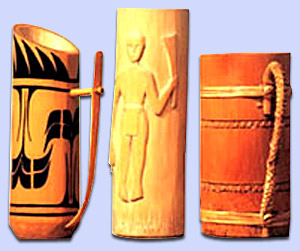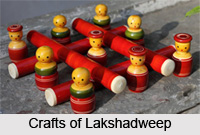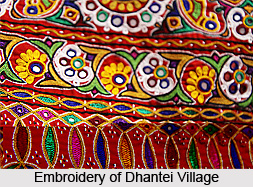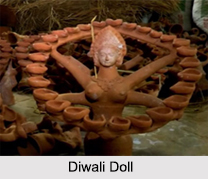 Diwali Dolls are mainly made for Diwali festival and they are available in the districts of Purulia and Medinipur in West Bengal. These two districts have certain distinctions in the forms and shapes of the dolls they produce. Diwali Dolls are mainly used for the illumination with the lamps which are provided on the hands of the dolls. Apart from that, these dolls have some spiritual significance- Diwali Dolls symbolize Goddess Lakhshmi, who increases wealth. Thus, Diwali Dolls are one of the most prominent features of Diwali festival.
Diwali Dolls are mainly made for Diwali festival and they are available in the districts of Purulia and Medinipur in West Bengal. These two districts have certain distinctions in the forms and shapes of the dolls they produce. Diwali Dolls are mainly used for the illumination with the lamps which are provided on the hands of the dolls. Apart from that, these dolls have some spiritual significance- Diwali Dolls symbolize Goddess Lakhshmi, who increases wealth. Thus, Diwali Dolls are one of the most prominent features of Diwali festival.
Shapes of Diwali Dolls
Diwali Dolls are mainly shaped in a female body, the lower portion of which is round and hollow and it serves as the stand of the lamps. The upper portion is given the shape of a female body whose arms are raised for putting lamps on each of the hand; a single lamp is put on the head of the doll. Thus, this doll is also called the "doll with three lamps".
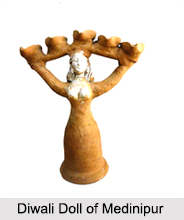 Types of Diwali Dolls
Types of Diwali Dolls
Apart from the "dolls with three lamps", "dolls with trays on their heads" are also found. The arms of these dolls are raised to hold the circular tray above their heads on which lamps are fixed in a neat arrangement. Sometimes, the dolls are seen to be carrying two semicircular trays with lamps on her shoulder, which are attached to a circular stand comprising the lower portion of the doll. Diwali Dolls are also shown to be carrying three, five, seven and nine lamps; dolls with seven lamps are called "Satbahania". Dolls with two lamps each on one hand are often adorned with a crown on their heads.
Formation of Diwali Dolls in Purulia
Potters of Purulia town, Balarampur, Jhalda, Adra, Kukadu and Hatatarh in Purulia district are found to have been making Diwali Dolls by joining separate parts of clay together. The number of lamps increases with the height of the dolls and size of the trays they hold. Sometimes, the number of lamps becomes higher than 13 or 16 with a height of 30 cm to one meter. Lastly, the dolls are burnt in fire and painted with powdered mica to give silvery hue to them; glossy pink and bright yellow colours are also used to paint the dolls. Upper portion of the dolls are decorated with red, blue, black, yellow and white colours, whereas lower part is adorned with the designs of flowers and leaves. Diwali Dolls of Purulia exhibit the figures of women, men, birds and animals.
Formation of Diwali Dolls in Medinipur
In Medinipur district, the potters of Manikpur and Mirzabazar villages produce the Diwali Dolls in two types – "traditional doll" and "fairy doll". Traditional doll is produced with lamps and fairy doll is made of terracotta provided with a wick and kerosene container. Generally, the height of the fairy dolls is from 30-50 cm. These dolls are also formed by joining different clay parts together. They are also burnt in fire and then given a coat of chalk before getting painted. The lower portion of the doll is painted in red, pink, green, blue or yellow colours with some ornamental decorations of leaves and flower motifs. Dolls of Medinipur predominantly exhibit the figures of women followed by the figures of birds, animals, Gods and Goddesses. The potters of this district also make Diwali Dolls with four or ten hands; the reproduction of Ravana is the most attractive Diwali Doll of Medinipur.



